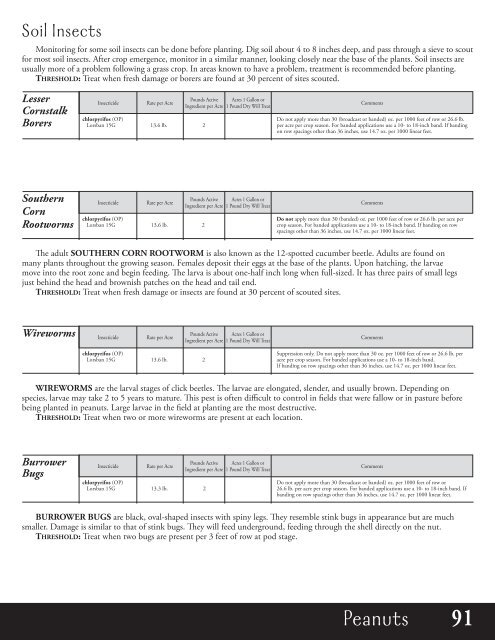Agronomic Crops
mJyPrJ
mJyPrJ
You also want an ePaper? Increase the reach of your titles
YUMPU automatically turns print PDFs into web optimized ePapers that Google loves.
Soil Insects<br />
Monitoring for some soil insects can be done before planting. Dig soil about 4 to 8 inches deep, and pass through a sieve to scout<br />
for most soil insects. After crop emergence, monitor in a similar manner, looking closely near the base of the plants. Soil insects are<br />
usually more of a problem following a grass crop. In areas known to have a problem, treatment is recommended before planting.<br />
tHResHoLD: Treat when fresh damage or borers are found at 30 percent of sites scouted.<br />
Lesser<br />
Cornstalk<br />
Borers<br />
Insecticide<br />
Rate per Acre<br />
chlorpyrifos (OP)<br />
Lorsban 15G 13.6 lb. 2<br />
Pounds Active Acres 1 Gallon or<br />
Ingredient per Acre 1 Pound Dry Will Treat<br />
Comments<br />
Do not apply more than 30 (broadcast or banded) oz. per 1000 feet of row or 26.6 lb.<br />
per acre per crop season. For banded applications use a 10- to 18-inch band. If banding<br />
on row spacings other than 36 inches, use 14.7 oz. per 1000 linear feet.<br />
Southern<br />
Corn<br />
Rootworms<br />
Insecticide<br />
Rate per Acre<br />
chlorpyrifos (OP)<br />
Lorsban 15G 13.6 lb. 2<br />
Pounds Active Acres 1 Gallon or<br />
Ingredient per Acre 1 Pound Dry Will Treat<br />
Comments<br />
Do not apply more than 30 (banded) oz. per 1000 feet of row or 26.6 lb. per acre per<br />
crop season. For banded applications use a 10- to 18-inch band. If banding on row<br />
spacings other than 36 inches, use 14.7 oz. per 1000 linear feet.<br />
e adult soUtHeRn CoRn RootWoRM is also known as the 12-spotted cucumber beetle. Adults are found on<br />
many plants throughout the growing season. Females deposit their eggs at the base of the plants. Upon hatching, the larvae<br />
move into the root zone and begin feeding. e larva is about one-half inch long when full-sized. It has three pairs of small legs<br />
just behind the head and brownish patches on the head and tail end.<br />
tHResHoLD: Treat when fresh damage or insects are found at 30 percent of scouted sites.<br />
Wireworms<br />
Insecticide<br />
Rate per Acre<br />
Pounds Active Acres 1 Gallon or<br />
Ingredient per Acre 1 Pound Dry Will Treat<br />
Comments<br />
chlorpyrifos (OP)<br />
Lorsban 15G 13.6 lb. 2<br />
Suppression only. Do not apply more than 30 oz. per 1000 feet of row or 26.6 lb. per<br />
acre per crop season. For banded applications use a 10- to 18-inch band.<br />
If banding on row spacings other than 36 inches, use 14.7 oz. per 1000 linear feet.<br />
WIReWoRMs are the larval stages of click beetles. e larvae are elongated, slender, and usually brown. Depending on<br />
species, larvae may take 2 to 5 years to mature. is pest is often difficult to control in fields that were fallow or in pasture before<br />
being planted in peanuts. Large larvae in the field at planting are the most destructive.<br />
tHResHoLD: Treat when two or more wireworms are present at each location.<br />
Burrower<br />
Bugs<br />
Insecticide<br />
Rate per Acre<br />
chlorpyrifos (OP)<br />
Lorsban 15G 13.3 lb. 2<br />
Pounds Active Acres 1 Gallon or<br />
Ingredient per Acre 1 Pound Dry Will Treat<br />
Comments<br />
Do not apply more than 30 (broadcast or banded) oz. per 1000 feet of row or<br />
26.6 lb. per acre per crop season. For banded applications use a 10- to 18-inch band. If<br />
banding on row spacings other than 36 inches, use 14.7 oz. per 1000 linear feet.<br />
BURRoWeR BUGs are black, oval-shaped insects with spiny legs. ey resemble stink bugs in appearance but are much<br />
smaller. Damage is similar to that of stink bugs. ey will feed underground, feeding through the shell directly on the nut.<br />
tHResHoLD: Treat when two bugs are present per 3 feet of row at pod stage.<br />
Peanuts 91


